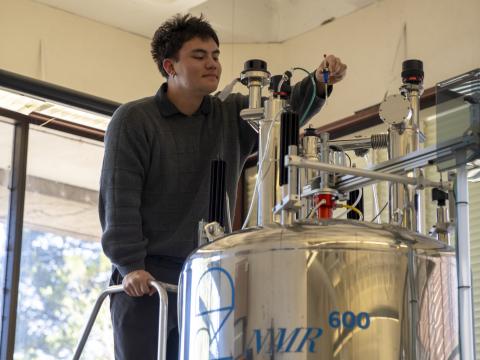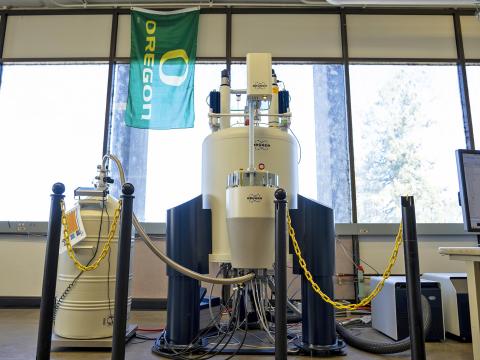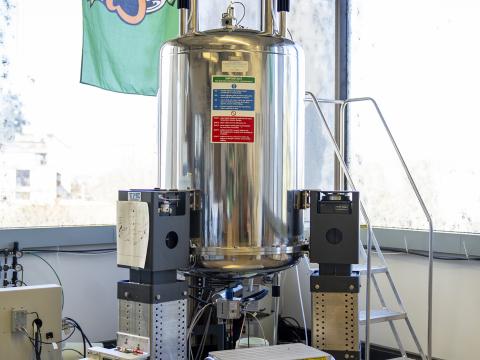Nuclear magnetic resonance (NMR) spectroscopy is achieved by exciting an atom's quantum spin state and examining the energy released during its relaxation. This provides information on the identity and environment of the molecules present. Additionally, the longer relaxation time scale associated with NMR allows for various molecular dynamics and kinetics to be studied.
Typical Applications
- Compound identification
- Molecular kinetics
- Molecular dynamics
- Molecular diffusion
- Mixture analysis
Instruments

Bruker Avance III-HD 600 NMR Spectrometer
- High dynamic range digital console with two RF channels, SGU3 high dynamic range receiver, HPLNA high power low noise preamplifier, and 2G DigiLock™ direct RF digital lock
- BLAH 300 watt 1H/19F transmitter and BLAX 500 watt 6-365 MHz BB transmitter
- GRASPTM II gradient spectroscopy
- SmartVT variable temperature control unit with BCU-II sample cooling to -50 ºC and NMR thermometer software
- Oxford 600/51 magnet with TMC anti-vibration legs
- TopSpin 3.5 pl2 software (CentOS Linux 5.11)
- Bruker 5mm ultra-high sensitivity multinuclear Prodigy™ CryoProbe (liquids):
- Observation and decoupling of 1H, 19F and X-nuclei (frequency range 31P–15N)
- Z-axis gradient coil and ATM
- Variable temperature range -40°C to +80°C
- Bruker 5mm multinuclear SmartProbe™ (liquids):
- Observation and decoupling of 1H, 19F and X-nuclei (frequency range 31P–109Ag)
- Z-axis gradient coil and ATM
- Supports 19F/1H decoupling and correlation experiments
- Variable temperature range -150°C to +150°C
- Bruker 4mm VTN multinuclear double resonance magic angle spinning probe (solids):
- Single coil for 15N–31P observe and 1H high-power decoupling & cross polarization
- Active sample volume: 50µl; maximum spin rate: 15 kHz
- Variable temperature range: -50 ºC to +80 ºC
- Funding provided by the National Science Foundation (NSF) CHE-092359 (ARRA) and the Oregon Nanoscience and Microtechnologies Institute (ONAMI).

Bruker Avance III-HD 500 NMR Spectrometer
- High dynamic range digital console with two RF channels, SGU3 high dynamic range receiver, HPPR/2 Preamplifier, and 2G DigiLock™, BOSS-3 shim system
- BLAXH 300/100 transmitter
- GRASPTM II gradient spectroscopy
- SmartVT variable temperature control unit with BCU-I Sample cooling to 0 ºC and NMR thermometer software
- ATM Automatic Tuning and Matching
- Ascend 500/54 magnet with gimbal (TMC) vibration isolators
- SampleCase 24-position sample changer
- TopSpin 3.5 pl4 software (CentOS Linux 5.11)
- Bruker 5mm ultra-high sensitivity multinuclear Prodigy™ CryoProbe (liquids):
- Observation and decoupling of 1H, 19F and X-nuclei (frequency range 31P–15N)
- Z-axis gradient coil; ATM Automatic Tuning and Matching
- Variable Temperature Range -40°C to +80°C
- Bruker 5mm multinuclear SmartProbe™ (liquids):
- Observation and decoupling of 1H, 19F and X-nuclei (frequency range 31P–109Ag)
- Quartz glassware to minimize 11B background
- Z-axis gradient coil; ATM Automatic Tuning and Matching
- Supports 19F/1H decoupling and correlation experiments
- Variable temperature range -150°C to +150°C
- Funding provided by NSF-MRI CHE-1427987, Oregon BEST, and ONAMI

Varian INOVA-500 NMR Spectrometer
- 3 RF-channels w/waveform generators
- Varian 5mm z-PFG AutoX DB probe for high frequency (1H–19F) and low frequency (15N– 31P) observe and decouple
- Nalorac DBG 5mm dual broadband probe: 15N–31P /1H–19F, z-axis PFG
- Nalorac IDTG 5mm triple resonance probe: 1H–19F{13C /15N}, z-axis PFG
- Nalorac BB 10mm broadband probe: 15N–31P{1H–19F}
- Automated 2H-gradient shimming
- Variable temperature control and FTS gas-stream cooler (-20C to +80C)
- Z-axis pulsed field gradients
- ProTune automated probe tuning/matching
- 1D, 2D, direct and indirect detection experiments
- VnmrJ 2.2D + ChemPack 4.1 software (RedHat Linux 5.6)
Instrument Contact: Casey Simons
